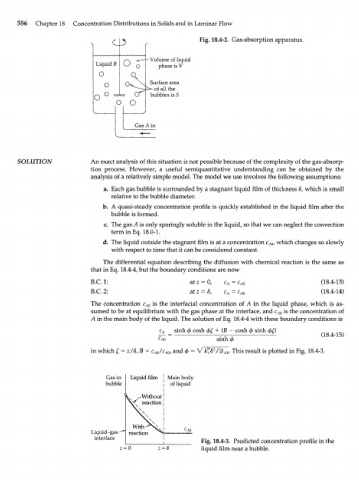Page 576 - Bird R.B. Transport phenomena
P. 576
556 Chapter 18 Concentration Distributions in Solids and in Laminar Flow
£ ^ Fig. 18.4-2. Gas-absorption apparatus.
Volume of liquid
phase is V
Surface area
of all the
bubbles is S
SOLUTION An exact analysis of this situation is not possible because of the complexity of the gas-absorp-
tion process. However, a useful semiquantitative understanding can be obtained by the
analysis of a relatively simple model. The model we use involves the following assumptions:
a. Each gas bubble is surrounded by a stagnant liquid film of thickness 5, which is small
relative to the bubble diameter.
b. A quasi-steady concentration profile is quickly established in the liquid film after the
bubble is formed.
c. The gas Л is only sparingly soluble in the liquid, so that we can neglect the convection
term in Eq. 18.0-1.
d. The liquid outside the stagnant film is at a concentration c , which changes so slowly
AS
with respect to time that it can be considered constant.
The differential equation describing the diffusion with chemical reaction is the same as
that in Eq. 18.4-4, but the boundary conditions are now
B.C. 1: at z = 0, C A ~ C AQ (18.4-13)
B.C. 2: at z = 5, С А = C AS (18.4-14)
The concentration c A0 is the interfacial concentration of Л in the liquid phase, which is as-
sumed to be at equilibrium with the gas phase at the interface, and c A8 is the concentration of
Л in the main body of the liquid. The solution of Eq. 18.4-4 with these boundary conditions is
sinh ф cosh ф£ + (B — cosh ф sinh ф£)
C sinh ф (18.4-15)
A0
in which I = z/8, В = c /c , and ф = \П^8 /ЯЬ . This result is plotted in Fig. 18.4-3.
2
A8
A0
АВ
Gas in Liquid film Main body
bubble of liquid
^-Without
ч
ЧУ^ reaction j
With
Liquid-gas ~ reaction CAB
interface Fig. 18.4-3. Predicted concentration profile in the
liquid film near a bubble.

